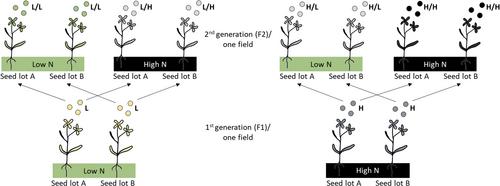The consequences of overfertilization on agricultural and native ecosystems are well-documented, but the impact of reduced fertilization on plant–microbe interactions is less understood. Here, we analysed the impact of different nitrogen (N) fertilization regimes over two subsequent growing seasons on the seed microbiome of winter oilseed rape (Brassica napus L.).
Seed microbial diversity, composition, and abundance were analysed by a combined approach of amplicon sequencing, quantitative real-time PCR, and microscopy. A germination assay was conducted to quantify bacteria and nifH genes in roots.
Two consecutive years of either low or high N fertilization resulted in a significant shift in seed microbiota; nine discriminating bacterial orders and 32 bacterial features were identified. Among them, potentially N-fixing bacteria (Rhizobiales and Rhizobium) were identified as biomarkers for low N fertilization. Moreover, quantitative measurements revealed that 16S ribosomal RNA (rRNA) and bacterial nifH gene counts were significantly higher under lower N availability. Relative to total 16S rRNA genes, seeds and roots contained 0.002% and 0.3% nifH genes on average, respectively. The alternation of N levels between the first and the second growing season (high to low, or low to high) had, however, no impact on seed microbiota, suggesting that a low N availability for at least two generations is required to enrich N-fixing taxa in seeds.
Our study revealed a flexible, environmentally influenced seed microbiome assembly and suggests innovative microbiome management via biological nitrogen fixation to optimize fertilization regimes in future agriculture.


